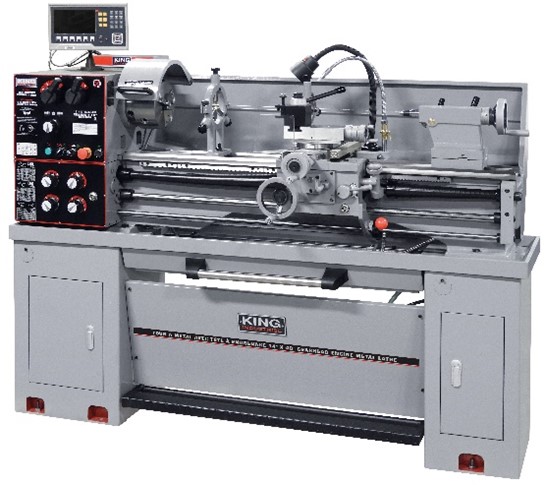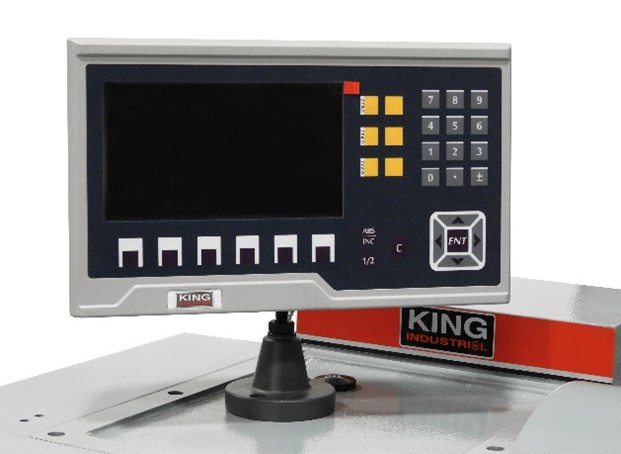
KBC Tools & Machinery announced that the KING KC-1440ML-2 14x40 lathe with a digital readout (DRO) is now available for immediate purchase at the company's Mississauga, Ontario, Canada, showroom.
The lathe comes factory-installed with the fully functional 2-axis (X, Y) digital readout (DRO).
Ted Fuller, vice president of King Canada, said, “In turning and machining, accuracy is paramount. Now the best in metal lathes comes with the best in Digital Read-Out (DRO) precision. Intelligent calibration is a vital element to repeatable precision, and it is now included at a great price. Everything you asked for in a complete turning package."
 Fuller added that with the KC-1440ML-2, simply learn how to use the DRO and start machining. The setup is intuitive, and the machine is easy to operate – exactly what every machinist wants. We all know the headaches of bunging up a scale or adding unnecessary holes when installing a DRO.
Fuller added that with the KC-1440ML-2, simply learn how to use the DRO and start machining. The setup is intuitive, and the machine is easy to operate – exactly what every machinist wants. We all know the headaches of bunging up a scale or adding unnecessary holes when installing a DRO.
Key Features:
- 2-hp motor for high-performance cutting
- 2” spindle bore capacity for versatility
- Factory-installed Digital Readout (DRO) – saves time and money, fully functional out of the box!
- No installation needed – just power up, learn how to use the machine and DRO, and start working
- Safety guard with limit switch protection
- Completely equipped: 7”-3 jaw chuck, 8”-4 jaw chuck, quick-change tool posts, steady rest, follow rest, D1-5 camlock faceplate, coolant system, and thread chasing dial indicator.
- CSA approved – eliminates electrical work or installation issues
The KING KC-1440ML-2 is the only unit available in Canada. KING’s official release is later this month, with stock expected to arrive in June.
Contact Details
Related Glossary Terms
- calibration
calibration
Checking measuring instruments and devices against a master set to ensure that, over time, they have remained dimensionally stable and nominally accurate.
- chuck
chuck
Workholding device that affixes to a mill, lathe or drill-press spindle. It holds a tool or workpiece by one end, allowing it to be rotated. May also be fitted to the machine table to hold a workpiece. Two or more adjustable jaws actually hold the tool or part. May be actuated manually, pneumatically, hydraulically or electrically. See collet.
- coolant
coolant
Fluid that reduces temperature buildup at the tool/workpiece interface during machining. Normally takes the form of a liquid such as soluble or chemical mixtures (semisynthetic, synthetic) but can be pressurized air or other gas. Because of water’s ability to absorb great quantities of heat, it is widely used as a coolant and vehicle for various cutting compounds, with the water-to-compound ratio varying with the machining task. See cutting fluid; semisynthetic cutting fluid; soluble-oil cutting fluid; synthetic cutting fluid.
- lathe
lathe
Turning machine capable of sawing, milling, grinding, gear-cutting, drilling, reaming, boring, threading, facing, chamfering, grooving, knurling, spinning, parting, necking, taper-cutting, and cam- and eccentric-cutting, as well as step- and straight-turning. Comes in a variety of forms, ranging from manual to semiautomatic to fully automatic, with major types being engine lathes, turning and contouring lathes, turret lathes and numerical-control lathes. The engine lathe consists of a headstock and spindle, tailstock, bed, carriage (complete with apron) and cross slides. Features include gear- (speed) and feed-selector levers, toolpost, compound rest, lead screw and reversing lead screw, threading dial and rapid-traverse lever. Special lathe types include through-the-spindle, camshaft and crankshaft, brake drum and rotor, spinning and gun-barrel machines. Toolroom and bench lathes are used for precision work; the former for tool-and-die work and similar tasks, the latter for small workpieces (instruments, watches), normally without a power feed. Models are typically designated according to their “swing,” or the largest-diameter workpiece that can be rotated; bed length, or the distance between centers; and horsepower generated. See turning machine.
- steady rest
steady rest
Supports long, thin or flexible work being turned on a lathe. Mounts on the bed’s ways and, unlike a follower rest, remains at the point where mounted. See follower rest.
- turning
turning
Workpiece is held in a chuck, mounted on a face plate or secured between centers and rotated while a cutting tool, normally a single-point tool, is fed into it along its periphery or across its end or face. Takes the form of straight turning (cutting along the periphery of the workpiece); taper turning (creating a taper); step turning (turning different-size diameters on the same work); chamfering (beveling an edge or shoulder); facing (cutting on an end); turning threads (usually external but can be internal); roughing (high-volume metal removal); and finishing (final light cuts). Performed on lathes, turning centers, chucking machines, automatic screw machines and similar machines.
